heater LINCOLN AVIATOR 2021 Owners Manual
[x] Cancel search | Manufacturer: LINCOLN, Model Year: 2021, Model line: AVIATOR, Model: LINCOLN AVIATOR 2021Pages: 667, PDF Size: 7.01 MB
Page 7 of 667
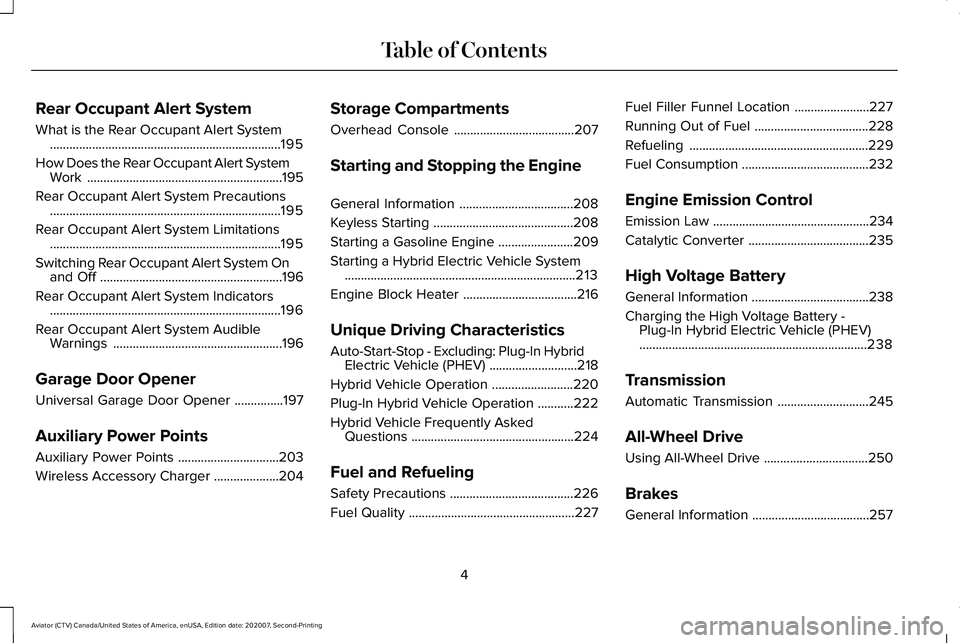
Rear Occupant Alert System
What is the Rear Occupant Alert System
.......................................................................195
How Does the Rear Occupant Alert System Work ............................................................
195
Rear Occupant Alert System Precautions .......................................................................
195
Rear Occupant Alert System Limitations .......................................................................
195
Switching Rear Occupant Alert System On and Off ........................................................
196
Rear Occupant Alert System Indicators .......................................................................
196
Rear Occupant Alert System Audible Warnings ....................................................
196
Garage Door Opener
Universal Garage Door Opener ...............
197
Auxiliary Power Points
Auxiliary Power Points ...............................
203
Wireless Accessory Charger ....................
204Storage Compartments
Overhead Console
.....................................
207
Starting and Stopping the Engine
General Information ...................................
208
Keyless Starting ...........................................
208
Starting a Gasoline Engine .......................
209
Starting a Hybrid Electric Vehicle System .......................................................................
213
Engine Block Heater ...................................
216
Unique Driving Characteristics
Auto-Start-Stop - Excluding: Plug-In Hybrid Electric Vehicle (PHEV) ...........................
218
Hybrid Vehicle Operation .........................
220
Plug-In Hybrid Vehicle Operation ...........
222
Hybrid Vehicle Frequently Asked Questions ..................................................
224
Fuel and Refueling
Safety Precautions ......................................
226
Fuel Quality ...................................................
227Fuel Filler Funnel Location
.......................
227
Running Out of Fuel ...................................
228
Refueling .......................................................
229
Fuel Consumption .......................................
232
Engine Emission Control
Emission Law ................................................
234
Catalytic Converter .....................................
235
High Voltage Battery
General Information ....................................
238
Charging the High Voltage Battery - Plug-In Hybrid Electric Vehicle (PHEV)
......................................................................
238
Transmission
Automatic Transmission ............................
245
All-Wheel Drive
Using All-Wheel Drive ................................
250
Brakes
General Information ....................................
257
4
Aviator (CTV) Canada/United States of America, enUSA, Edition date: 202007, Second-Printing Table of Contents
Page 219 of 667
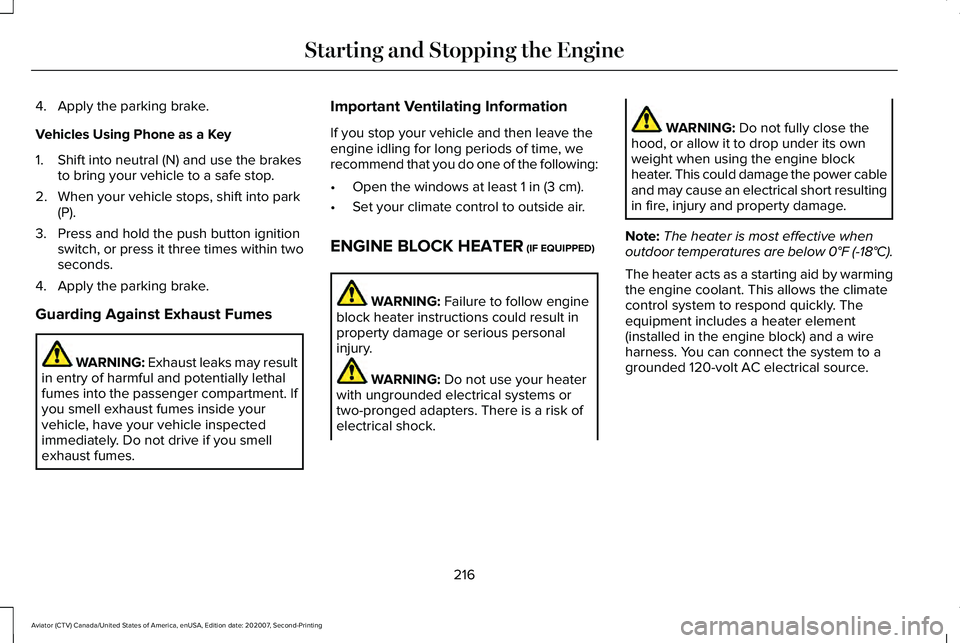
4. Apply the parking brake.
Vehicles Using Phone as a Key
1. Shift into neutral (N) and use the brakes
to bring your vehicle to a safe stop.
2. When your vehicle stops, shift into park (P).
3. Press and hold the push button ignition switch, or press it three times within two
seconds.
4. Apply the parking brake.
Guarding Against Exhaust Fumes WARNING: Exhaust leaks may result
in entry of harmful and potentially lethal
fumes into the passenger compartment. If
you smell exhaust fumes inside your
vehicle, have your vehicle inspected
immediately. Do not drive if you smell
exhaust fumes. Important Ventilating Information
If you stop your vehicle and then leave the
engine idling for long periods of time, we
recommend that you do one of the following:
•
Open the windows at least 1 in (3 cm).
• Set your climate control to outside air.
ENGINE BLOCK HEATER
(IF EQUIPPED) WARNING:
Failure to follow engine
block heater instructions could result in
property damage or serious personal
injury. WARNING:
Do not use your heater
with ungrounded electrical systems or
two-pronged adapters. There is a risk of
electrical shock. WARNING:
Do not fully close the
hood, or allow it to drop under its own
weight when using the engine block
heater. This could damage the power cable
and may cause an electrical short resulting
in fire, injury and property damage.
Note: The heater is most effective when
outdoor temperatures are below
0°F (-18°C).
The heater acts as a starting aid by warming
the engine coolant. This allows the climate
control system to respond quickly. The
equipment includes a heater element
(installed in the engine block) and a wire
harness. You can connect the system to a
grounded 120-volt AC electrical source.
216
Aviator (CTV) Canada/United States of America, enUSA, Edition date: 202007, Second-Printing Starting and Stopping the Engine
Page 220 of 667
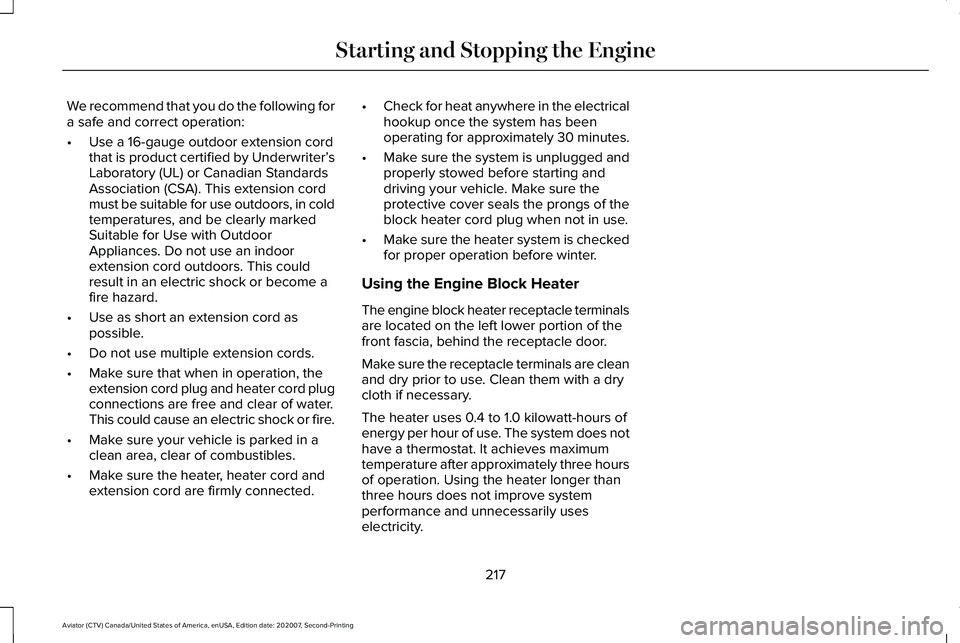
We recommend that you do the following for
a safe and correct operation:
•
Use a 16-gauge outdoor extension cord
that is product certified by Underwriter’ s
Laboratory (UL) or Canadian Standards
Association (CSA). This extension cord
must be suitable for use outdoors, in cold
temperatures, and be clearly marked
Suitable for Use with Outdoor
Appliances. Do not use an indoor
extension cord outdoors. This could
result in an electric shock or become a
fire hazard.
• Use as short an extension cord as
possible.
• Do not use multiple extension cords.
• Make sure that when in operation, the
extension cord plug and heater cord plug
connections are free and clear of water.
This could cause an electric shock or fire.
• Make sure your vehicle is parked in a
clean area, clear of combustibles.
• Make sure the heater, heater cord and
extension cord are firmly connected. •
Check for heat anywhere in the electrical
hookup once the system has been
operating for approximately 30 minutes.
• Make sure the system is unplugged and
properly stowed before starting and
driving your vehicle. Make sure the
protective cover seals the prongs of the
block heater cord plug when not in use.
• Make sure the heater system is checked
for proper operation before winter.
Using the Engine Block Heater
The engine block heater receptacle terminals
are located on the left lower portion of the
front fascia, behind the receptacle door.
Make sure the receptacle terminals are clean
and dry prior to use. Clean them with a dry
cloth if necessary.
The heater uses 0.4 to 1.0 kilowatt-hours of
energy per hour of use. The system does not
have a thermostat. It achieves maximum
temperature after approximately three hours
of operation. Using the heater longer than
three hours does not improve system
performance and unnecessarily uses
electricity.
217
Aviator (CTV) Canada/United States of America, enUSA, Edition date: 202007, Second-Printing Starting and Stopping the Engine
Page 377 of 667
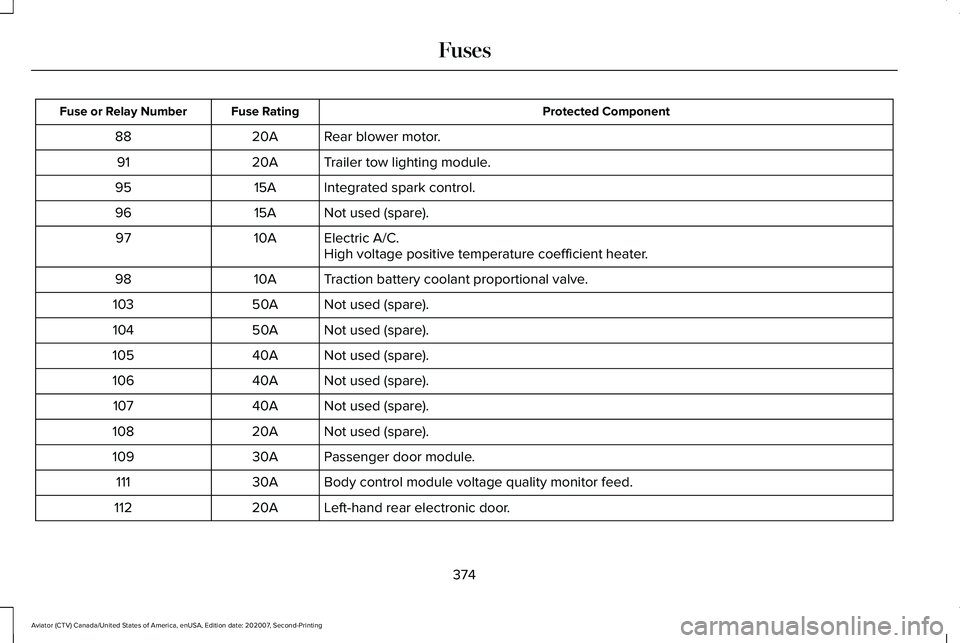
Protected Component
Fuse Rating
Fuse or Relay Number
Rear blower motor.
20A
88
Trailer tow lighting module.
20A
91
Integrated spark control.
15A
95
Not used (spare).
15A
96
Electric A/C.
10A
97
High voltage positive temperature coefficient heater.
Traction battery coolant proportional valve.
10A
98
Not used (spare).
50A
103
Not used (spare).
50A
104
Not used (spare).
40A
105
Not used (spare).
40A
106
Not used (spare).
40A
107
Not used (spare).
20A
108
Passenger door module.
30A
109
Body control module voltage quality monitor feed.
30A
111
Left-hand rear electronic door.
20A
112
374
Aviator (CTV) Canada/United States of America, enUSA, Edition date: 202007, Second-Printing Fuses
Page 431 of 667
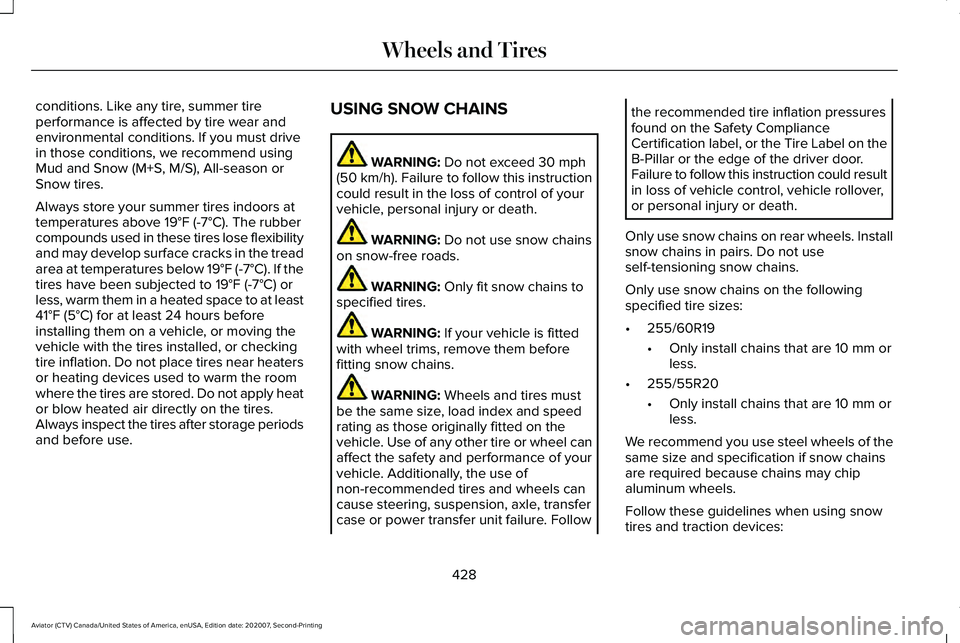
conditions. Like any tire, summer tire
performance is affected by tire wear and
environmental conditions. If you must drive
in those conditions, we recommend using
Mud and Snow (M+S, M/S), All-season or
Snow tires.
Always store your summer tires indoors at
temperatures above 19°F (-7°C). The rubber
compounds used in these tires lose flexibility
and may develop surface cracks in the tread
area at temperatures below
19°F (-7°C). If the
tires have been subjected to 19°F (-7°C) or
less, warm them in a heated space to at least
41°F (5°C)
for at least 24 hours before
installing them on a vehicle, or moving the
vehicle with the tires installed, or checking
tire inflation. Do not place tires near heaters
or heating devices used to warm the room
where the tires are stored. Do not apply heat
or blow heated air directly on the tires.
Always inspect the tires after storage periods
and before use. USING SNOW CHAINS WARNING:
Do not exceed 30 mph
(50 km/h). Failure to follow this instruction
could result in the loss of control of your
vehicle, personal injury or death. WARNING:
Do not use snow chains
on snow-free roads. WARNING:
Only fit snow chains to
specified tires. WARNING:
If your vehicle is fitted
with wheel trims, remove them before
fitting snow chains. WARNING:
Wheels and tires must
be the same size, load index and speed
rating as those originally fitted on the
vehicle. Use of any other tire or wheel can
affect the safety and performance of your
vehicle. Additionally, the use of
non-recommended tires and wheels can
cause steering, suspension, axle, transfer
case or power transfer unit failure. Follow the recommended tire inflation pressures
found on the Safety Compliance
Certification label, or the Tire Label on the
B-Pillar or the edge of the driver door.
Failure to follow this instruction could result
in loss of vehicle control, vehicle rollover,
or personal injury or death.
Only use snow chains on rear wheels. Install
snow chains in pairs. Do not use
self-tensioning snow chains.
Only use snow chains on the following
specified tire sizes:
• 255/60R19
•Only install chains that are 10 mm or
less.
• 255/55R20
•Only install chains that are 10 mm or
less.
We recommend you use steel wheels of the
same size and specification if snow chains
are required because chains may chip
aluminum wheels.
Follow these guidelines when using snow
tires and traction devices:
428
Aviator (CTV) Canada/United States of America, enUSA, Edition date: 202007, Second-Printing Wheels and Tires
Page 535 of 667
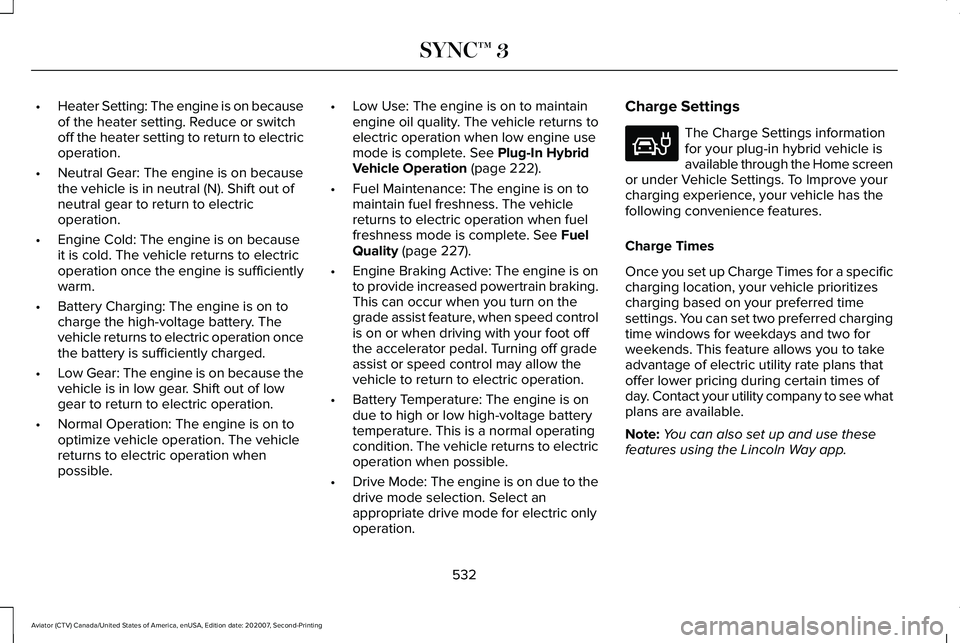
•
Heater Setting: The engine is on because
of the heater setting. Reduce or switch
off the heater setting to return to electric
operation.
• Neutral Gear: The engine is on because
the vehicle is in neutral (N). Shift out of
neutral gear to return to electric
operation.
• Engine Cold: The engine is on because
it is cold. The vehicle returns to electric
operation once the engine is sufficiently
warm.
• Battery Charging: The engine is on to
charge the high-voltage battery. The
vehicle returns to electric operation once
the battery is sufficiently charged.
• Low Gear: The engine is on because the
vehicle is in low gear. Shift out of low
gear to return to electric operation.
• Normal Operation: The engine is on to
optimize vehicle operation. The vehicle
returns to electric operation when
possible. •
Low Use: The engine is on to maintain
engine oil quality. The vehicle returns to
electric operation when low engine use
mode is complete. See Plug-In Hybrid
Vehicle Operation (page 222).
• Fuel Maintenance: The engine is on to
maintain fuel freshness. The vehicle
returns to electric operation when fuel
freshness mode is complete.
See Fuel
Quality (page 227).
• Engine Braking Active: The engine is on
to provide increased powertrain braking.
This can occur when you turn on the
grade assist feature, when speed control
is on or when driving with your foot off
the accelerator pedal. Turning off grade
assist or speed control may allow the
vehicle to return to electric operation.
• Battery Temperature: The engine is on
due to high or low high-voltage battery
temperature. This is a normal operating
condition. The vehicle returns to electric
operation when possible.
• Drive Mode: The engine is on due to the
drive mode selection. Select an
appropriate drive mode for electric only
operation. Charge Settings The Charge Settings information
for your plug-in hybrid vehicle is
available through the Home screen
or under Vehicle Settings. To Improve your
charging experience, your vehicle has the
following convenience features.
Charge Times
Once you set up Charge Times for a specific
charging location, your vehicle prioritizes
charging based on your preferred time
settings. You can set two preferred charging
time windows for weekdays and two for
weekends. This feature allows you to take
advantage of electric utility rate plans that
offer lower pricing during certain times of
day. Contact your utility company to see what
plans are available.
Note: You can also set up and use these
features using the Lincoln Way app.
532
Aviator (CTV) Canada/United States of America, enUSA, Edition date: 202007, Second-Printing SYNC™ 3E304452
Page 543 of 667
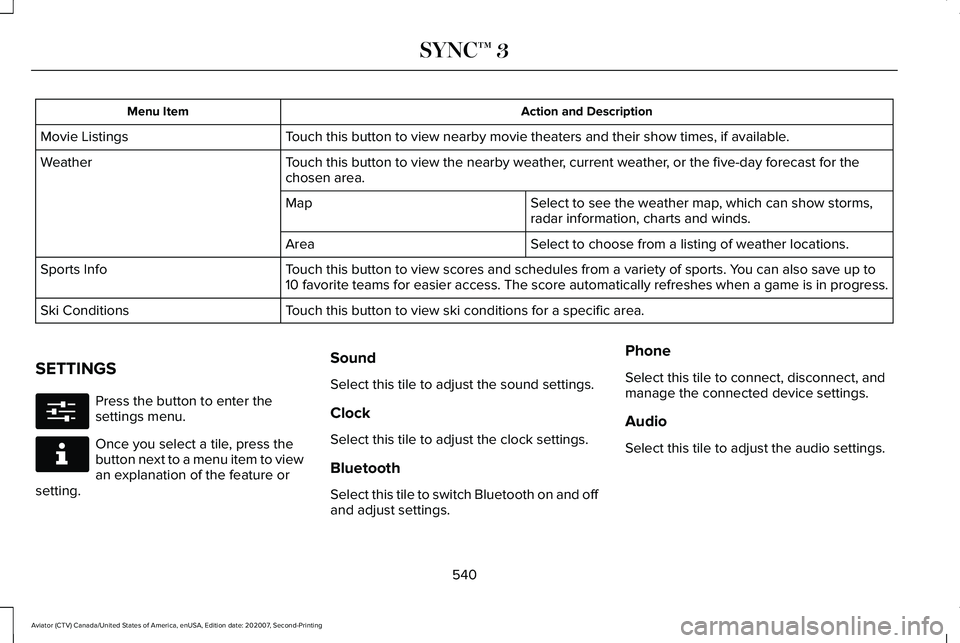
Action and Description
Menu Item
Touch this button to view nearby movie theaters and their show times, if \
available.
Movie Listings
Touch this button to view the nearby weather, current weather, or the five-day forecast for the
chosen area.
Weather
Select to see the weather map, which can show storms,
radar information, charts and winds.
Map
Select to choose from a listing of weather locations.
Area
Touch this button to view scores and schedules from a variety of sports. \
You can also save up to
10 favorite teams for easier access. The score automatically refreshes w\
hen a game is in progress.
Sports Info
Touch this button to view ski conditions for a specific area.
Ski Conditions
SETTINGS Press the button to enter the
settings menu.
Once you select a tile, press the
button next to a menu item to view
an explanation of the feature or
setting. Sound
Select this tile to adjust the sound settings.
Clock
Select this tile to adjust the clock settings.
Bluetooth
Select this tile to switch Bluetooth on and off
and adjust settings.Phone
Select this tile to connect, disconnect, and
manage the connected device settings.
Audio
Select this tile to adjust the audio settings.
540
Aviator (CTV) Canada/United States of America, enUSA, Edition date: 202007, Second-Printing SYNC™ 3E280315 E268570
Page 570 of 667
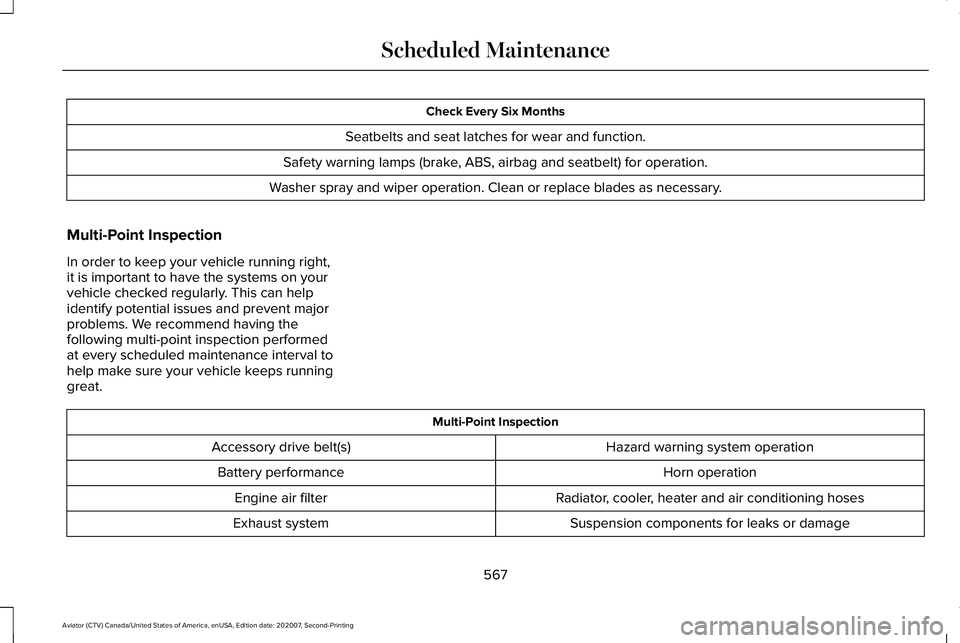
Check Every Six Months
Seatbelts and seat latches for wear and function.
Safety warning lamps (brake, ABS, airbag and seatbelt) for operation.
Washer spray and wiper operation. Clean or replace blades as necessary.
Multi-Point Inspection
In order to keep your vehicle running right,
it is important to have the systems on your
vehicle checked regularly. This can help
identify potential issues and prevent major
problems. We recommend having the
following multi-point inspection performed
at every scheduled maintenance interval to
help make sure your vehicle keeps running
great. Multi-Point Inspection
Hazard warning system operation
Accessory drive belt(s)
Horn operation
Battery performance
Radiator, cooler, heater and air conditioning hoses
Engine air filter
Suspension components for leaks or damage
Exhaust system
567
Aviator (CTV) Canada/United States of America, enUSA, Edition date: 202007, Second-Printing Scheduled Maintenance
Page 655 of 667
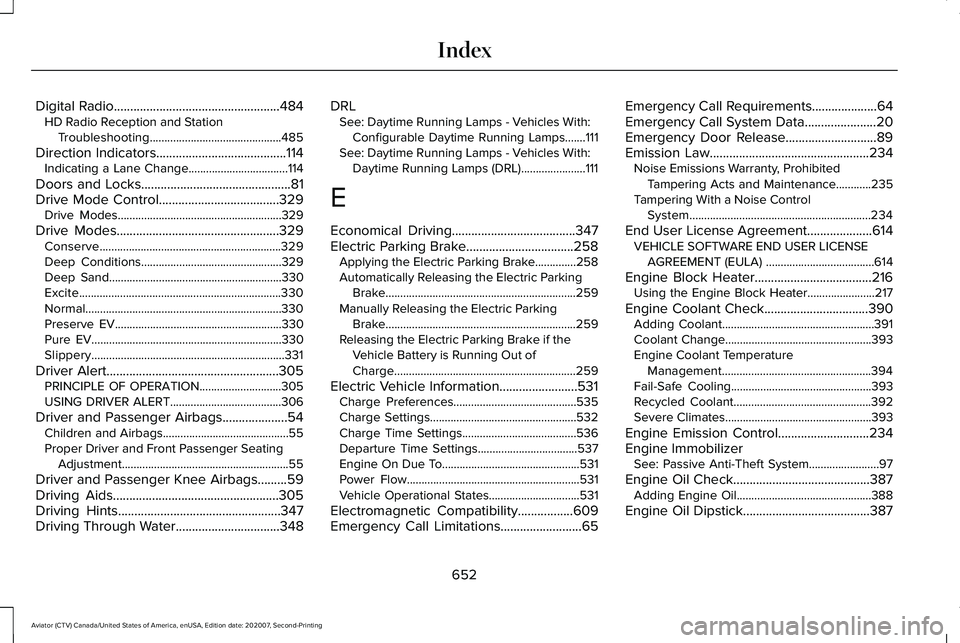
Digital Radio...................................................484
HD Radio Reception and Station
Troubleshooting.............................................485
Direction Indicators
........................................114
Indicating a Lane Change..................................114
Doors and Locks..............................................81
Drive Mode Control.....................................329 Drive Modes........................................................329
Drive Modes
..................................................329
Conserve..............................................................329
Deep Conditions................................................329
Deep Sand...........................................................330
Excite.....................................................................330
Normal...................................................................330
Preserve EV.........................................................330
Pure EV.................................................................330
Slippery..................................................................331
Driver Alert.....................................................305 PRINCIPLE OF OPERATION............................305
USING DRIVER ALERT......................................306
Driver and Passenger Airbags....................54 Children and Airbags...........................................55
Proper Driver and Front Passenger Seating
Adjustment.........................................................55
Driver and Passenger Knee Airbags.........59
Driving Aids
...................................................305
Driving Hints..................................................347
Driving Through Water................................348 DRL
See: Daytime Running Lamps - Vehicles With:
Configurable Daytime Running Lamps.......111
See: Daytime Running Lamps - Vehicles With: Daytime Running Lamps (DRL)......................111
E
Economical Driving......................................347
Electric Parking Brake.................................258 Applying the Electric Parking Brake..............258
Automatically Releasing the Electric Parking
Brake.................................................................259
Manually Releasing the Electric Parking Brake.................................................................259
Releasing the Electric Parking Brake if the Vehicle Battery is Running Out of
Charge..............................................................259
Electric Vehicle Information
........................531
Charge Preferences..........................................535
Charge Settings..................................................532
Charge Time Settings.......................................536
Departure Time Settings..................................537
Engine On Due To...............................................531
Power Flow...........................................................531
Vehicle Operational States...............................531
Electromagnetic Compatibility.................609
Emergency Call Limitations.........................65 Emergency Call Requirements....................64
Emergency Call System Data......................20
Emergency Door Release............................89
Emission Law
.................................................234
Noise Emissions Warranty, Prohibited
Tampering Acts and Maintenance............
235
Tampering With a Noise Control System..............................................................234
End User License Agreement....................614 VEHICLE SOFTWARE END USER LICENSE
AGREEMENT (EULA) .....................................614
Engine Block Heater....................................216 Using the Engine Block Heater.......................217
Engine Coolant Check................................390 Adding Coolant....................................................391
Coolant Change..................................................393
Engine Coolant Temperature
Management...................................................394
Fail-Safe Cooling................................................393
Recycled Coolant...............................................392
Severe Climates..................................................393
Engine Emission Control
............................234
Engine Immobilizer See: Passive Anti-Theft System........................97
Engine Oil Check..........................................387 Adding Engine Oil..............................................388
Engine Oil Dipstick.......................................387
652
Aviator (CTV) Canada/United States of America, enUSA, Edition date: 202007, Second-Printing Index